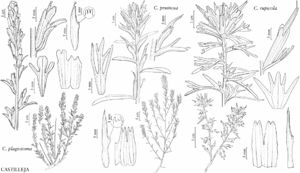Castilleja plagiotoma
Proc. Amer. Acad. Arts 19: 93. 1883. (as Castilleia)
Herbs, perennial, 2.3–5.3(–6) dm; from a woody caudex; with a taproot. Stems several, erect to weakly ascending, often leaning on nearby shrubs, much-branched, often with short, leafy axillary shoots, hairs sparse, spreading, short or long, soft, branched or unbranched, eglandular. Leaves gray-green or green to purple to ± deep red, linear or linear-lanceolate, 2–5 cm, not fleshy, margins plane to ± wavy, flat or involute, 3–5(–7)-lobed, apex acuminate to acute; lobes spreading-ascending, sometimes widely so, narrowly linear, apex acute or obtuse. Inflorescences 3–20 × 0.5–1.5 cm; bracts green throughout, sometimes tinged dull purple, proximal sometimes linear-lanceolate, distal or all bracts oblong, 3–5(–7)-lobed; lobes spreading to ascending, linear to oblanceolate, short to long, proximal lobes arising near mid length, sometimes wavy-margined, central lobe apex rounded to truncate, lateral ones obtuse to rounded. Calyces light green, cream, or light yellow, often appearing white from dense white-woolly pubescence, 10–18 mm; abaxial clefts 5–6.5 mm, closed by intertwined hairs and appearing 2 mm deep, adaxial 2.2–4.2 mm, abaxial ca. 25% of calyx length, adaxial ca. 20% of calyx length, shallower (or appearing much shallower), than laterals, lateral 4.6–7.5 mm, ca. 50% of calyx length; lobes: abaxial segments broad, paddle-shaped, 7 mm, inner surface of abaxial segments densely white-woolly, apex rounded to broadly obtuse, adaxial narrowly triangular, 5 mm, apex acute. Corollas straight, 13–20 mm; tube 5–7 mm; beak short-exserted, sometimes shorter than abaxial calyx segments, adaxially yellow, rarely greenish, 7–10 mm; abaxial lip pale green to yellowish, reduced, 0.5–1.5 mm, 7–17% as long as beak; teeth reduced to apiculations, pale green to yellowish, 0.5–0.8 mm.
Phenology: Flowering Mar–Jul.
Habitat: Dry flats, rocky, sandy, or clayey slopes, ridges, sagebrush steppes, chaparral, desert scrub, pinyon woodlands.
Elevation: 200–2500 m.
Distribution
Calif.
Discussion
Castilleja plagiotoma is unique in the genus in the structure of its calyces, with the lateral clefts deeper than the median clefts. The relative lengths of the calyx lobes are also unique, with the abaxial lobes exceeding the adaxial lobes by 2–3 mm. The abaxial lobes also bear a dense indument of whitish, branched hairs. The uniformly greenish bracts are uncommon among perennial species of Castilleja. Castilleja plagiotoma is scattered in the western Mojave Desert and the hills adjacent to the southwestern San Joaquin Valley, California. While not of immediate conservation concern, this species is uncommon and increasingly threatened by recreational vehicles, livestock grazing, residential development, and resource extraction.
Castilleja plagiotoma is most often associated with and is likely parasitic on Eriogonum fasciculatum var. polifolium, but it is also often observed with Artemisia tridentata or other species. It is a known larval host plant for the butterfly, Euphydryas editha subsp. erlichii.
Selected References
None.
